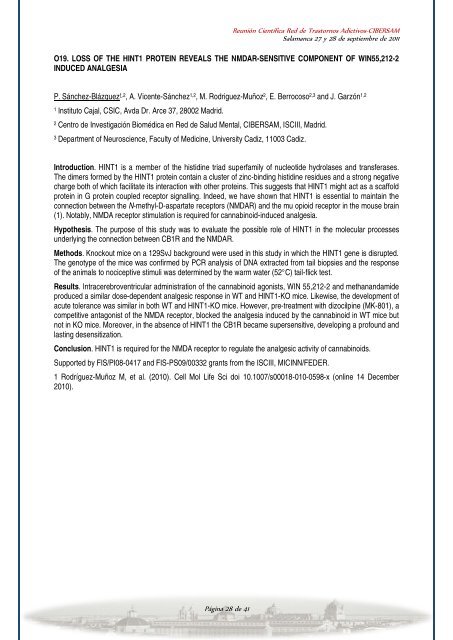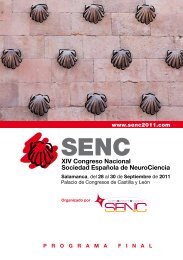Reunión Científica Red <strong>de</strong> Trastornos Adictivos-CIBERSAMSa<strong>la</strong>manca 27 y 28 <strong>de</strong> septiembre <strong>de</strong> 2011O19. LOSS OF THE HINT1 PROTEIN REVEALS THE NMDAR-SENSITIVE COMPONENT OF WIN55,212-2INDUCED ANALGESIAP. Sánchez-Blázquez 1,2 , A. Vicente-Sánchez 1,2 , M. Rodriguez-Muñoz 2 , E. Berrocoso 2,3 and J. Garzón 1,21Instituto Cajal, CSIC, Avda Dr. Arce 37, 28002 Madrid.2Centro <strong>de</strong> Investigación Biomédica en Red <strong>de</strong> Salud Mental, CIBERSAM, ISCIII, Madrid.3Department of Neuroscience, Faculty of Medicine, University Cadiz, 11003 Cadiz.Introduction. HINT1 is a member of the histidine triad superfamily of nucleoti<strong>de</strong> hydro<strong>la</strong>ses and transferases.The dimers formed by the HINT1 protein contain a cluster of zinc-binding histidine residues and a strong negativecharge both of which facilitate its interaction with other proteins. This suggests that HINT1 might act as a scaffoldprotein in G protein coupled receptor signalling. In<strong>de</strong>ed, we have shown that HINT1 is essential to maintain theconnection between the N-methyl-D-aspartate receptors (NMDAR) and the mu opioid receptor in the mouse brain(1). Notably, NMDA receptor stimu<strong>la</strong>tion is required for cannabinoid-induced analgesia.Hypothesis. The purpose of this study was to evaluate the possible role of HINT1 in the molecu<strong>la</strong>r processesun<strong>de</strong>rlying the connection between CB1R and the NMDAR.Methods. Knockout mice on a 129SvJ background were used in this study in which the HINT1 gene is disrupted.The genotype of the mice was confirmed by PCR analysis of DNA extracted from tail biopsies and the responseof the animals to nociceptive stimuli was <strong>de</strong>termined by the warm water (52°C) tail-flick test.Results. Intracerebroventricu<strong>la</strong>r administration of the cannabinoid agonists, WIN 55,212-2 and methanandami<strong>de</strong>produced a simi<strong>la</strong>r dose-<strong>de</strong>pen<strong>de</strong>nt analgesic response in WT and HINT1-KO mice. Likewise, the <strong>de</strong>velopment ofacute tolerance was simi<strong>la</strong>r in both WT and HINT1-KO mice. However, pre-treatment with dizocilpine (MK-801), acompetitive antagonist of the NMDA receptor, blocked the analgesia induced by the cannabinoid in WT mice butnot in KO mice. Moreover, in the absence of HINT1 the CB1R became supersensitive, <strong>de</strong>veloping a profound and<strong>la</strong>sting <strong>de</strong>sensitization.Conclusion. HINT1 is required for the NMDA receptor to regu<strong>la</strong>te the analgesic activity of cannabinoids.Supported by FIS/PI08-0417 and FIS-PS09/00332 grants from the ISCIII, MICINN/FEDER.1 Rodríguez-Muñoz M, et al. (2010). Cell Mol Life Sci doi 10.1007/s00018-010-0598-x (online 14 December2010).Página 28 <strong>de</strong> 41
Reunión Científica Red <strong>de</strong> Trastornos Adictivos-CIBERSAMSa<strong>la</strong>manca 27 y 28 <strong>de</strong> septiembre <strong>de</strong> 2011O20. ULTRASTRUCTURAL IMMUNOLOCALIZATION OF THE CB1 CANNABINOID RECEPTOR INGLUTAMATERGIC AND GABAERGIC SYNAPTIC TERMINALS IN THE MOUSE VENTROMEDIAL NUCLEUSOF THE HYPOTHALAMUSL. Reguero 1 , N. Puente 1 , I. Elezgarai 1 , J.L. Mendizabal Zubiaga 1 , M.J. Candue<strong>la</strong> 1 , I. Buceta 1 , A. Ramos 1 , J.Suárez 2 , F. Rodríguez <strong>de</strong> Fonseca 2 , G. Marsicano 3 , P. Gran<strong>de</strong>s 11. Faculty of Medicine and Dentistry, Basque Country University, Bilbao, Spain2. Fundación IMABIS, Má<strong>la</strong>ga, Spain3. INSERM U862 NeuroCentre Magendie/Université Bor<strong>de</strong>aux 2, Bor<strong>de</strong>aux, FranceIt is well established that the hypotha<strong>la</strong>mus and the endocannabinoid system are involved in the regu<strong>la</strong>tion offood intake and energy ba<strong>la</strong>nce. The ventromedial nucleus of the hypotha<strong>la</strong>mus (VMH) is associated withhomeostatic and behavioral functions, including regu<strong>la</strong>tion of appetite and energy ba<strong>la</strong>nce. Type 1 cannabinoidreceptors (CB 1) are present at low levels in most hypotha<strong>la</strong>mic nuclei. However, a <strong>de</strong>tailed knowledge of theprecise anatomical localization of CB 1 mediating the endocannabinoid control of glutamatergic and GABAergictransmission in food intake is mandatory.The aim of this study was to analyze the subcellu<strong>la</strong>r distribution of CB 1 in the mouse VMH. For this purpose, weused two conditional mutant mice with a selective <strong>de</strong>letion of CB 1 mainly from cortical glutamatergic (Glu-CB 1-KO) and from forebrain GABAergic neurons (GABA-CB 1-KO), as well as full CB 1-KO animals. Pre-embeddingimmunocytochemical techniques for light and high resolution electron microscopy were used.At light microscopy, CB 1 immunoreactivity was uniformly distributed throughout the VMH of CB 1-WT and Glu-CB 1-KO mice. However, CB 1 immunostaining was drastically reduced in the VMH of GABA-CB 1-KO mice,particu<strong>la</strong>rly in the dorsomedial part, suggesting the presence of CB 1 in GABAergic profiles. The immuno<strong>la</strong>bellingfully disappeared in CB 1-KO mice. In the electron microscope, CB 1 immunoparticles were typically localized onpreterminals and/or synaptic terminals. To <strong>de</strong>fine the contribution of cortical glutamatergic and GABAergicterminals to the intrinsic CB 1 pattern in the VMH, Glu-CB 1-KO and GABA-CB 1-KO mice were used. CB 1 was stillobserved in VMH terminals of both mutant strains. The statistical analysis revealed that synapticterminals/preterminals immunopositive for CB 1 in CB 1-WT (20.4%) and Glu-CB 1-KO mice (20.8%) were reducedin GABA-CB 1-KO mutants (12.4%). CB 1 <strong>de</strong>nsity was simi<strong>la</strong>r (0.5 immunoparticles/µm) in all animal conditions.These anatomical data support the VMH as a hub candidate in the endocannabinoid-mediated modu<strong>la</strong>tion of theexcitatory and inhibitory neurotransmission of intrahypotha<strong>la</strong>mic pathways regu<strong>la</strong>ting food intake.Acknowledgments: Dr. P. Gran<strong>de</strong>s' <strong>la</strong>boratory is supported by GIC07/70-IT-432-07, SAF2009-07065 and by Red<strong>de</strong> Trastornos Adictivos, RETICS, Instituto <strong>de</strong> Salud Carlos III, MICINN, grant RD07/0001/2001 (M.J. Candue<strong>la</strong>).L. Reguero is in receipt of a Predoctoral Fellowship from the Basque Country Government (BFI 07.286). I. Bucetais supported by a Predoctoral Fellowship from the Basque Country University.Página 29 <strong>de</strong> 41




